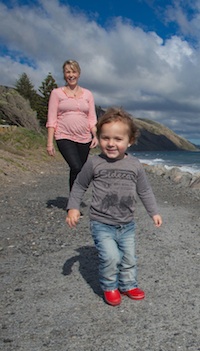Firstly congratulations on your pregnancy. What an exciting time lies ahead. There are many wonderful exercise opportunities for you to explore while you are pregnant.
One of the most important things about exercise during pregnancy is that you’re now exercising for 2.
Now is not the time to get out and get crazy-fit or try out a new sport. Nor is it the time to sit down and do no exercise. There are many wonderful benefits to exercising during pregnancy.
Exercise during pregnancy
Benefits of exercise during pregnancy
– Improve mood and self esteem
– Maintain cardiovascular fitness
– Awareness of body posture
– Prevention of some problems associated with pregnancy
– Maintain bone strength
– Weight control
– Help the body to prepare for labour
– Assist with return to pre pregnancy weight and body shape
– Create the opportunity to meet other pregnant mums
It is imperative that you check with your Lead Maternity Carer before embarking on any exercise routine. There are many conditions of pregnancy where exercise is not advised. There are also some conditions where precautions need to be taken.
Pregnancy is not the time to start to get fit; it is more about the maintenance of the fitness you had prior to conception. For example starting out power walking when pregnant wouldn’t be a good idea if you had never gone at that pace prior to conception.
With any new exercise start off light and build up slowly. Listen to your body. Seek professional advice from someone qualified in the area of pregnancy exercise.
Cardiovascular Exercise
Top tips for cardiovascular exercise in pregnancy:
– Keep it low impact
– Walking and aqua aerobics are good options
– Use the talk test as a guide to level of intensity (this means that if your can talk during your exercise this is a good level for you).
– Wear supportive footwear as feet have extra load through them in pregnancy.
– Keep your clothing light, and breathable.
– Remember to hydrate and eat well after exercising.
– Limit walking to 15-40 minutes depending on your level of fitness prior to conception.
– Cardiovascular exercise 3-4 times a week is adequate.
Things to be aware of
– Relaxin hormone relaxes the ligaments. Keep exercise light and non-jarring.
– The baby is dependent on mother for disposal of heat. This is particularly important in the first trimester when the baby’s organs are forming.
– Be mindful that your body temperature is already elevated just by being pregnant by 0.5 degrees.
– Your breathing rate and heart rate are increased already too as a result of pregnancy.
– Avoid contact sports.
– Avoid high impact exercise.
– Avoid exercise that could offset your balance or cause you to fall.
– Avoid exercise that causes jolts or jarring of the joints.
– Avoid exercise that would place further strain on the pelvic floor.
Resistance Exercise
It is a good idea to do a pregnancy class that involves resistance exercise.
– Always seek the advice of a personal trainer who is trained to work with pregnant women. They will give you the right guidelines.
– It is great for keeping bones and muscles strong. It will keep your body nice and toned.
– It can help to keep weight gain under control
– If you haven’t used weights before keep resistance low with higher reps.
– Dynabands are a great alternative to weights.
– Relaxin hormone is active throughout pregnancy. Too much load can impact on joint stability and pelvic floor.
– Keep your pelvic floor supported. Where possible use a swiss ball or a seat when using weights to reduce pressure through your pelvic floor.
– Avoid deep, wide or loaded squats. Instead, keep to a narrow base (shoulder width apart) with squats. Keep the squat shallow and avoid adding extra load.
– Ensure good technique and posture.
– Avoid lying on you back after 16 weeks. Lying supine may create impaired blood supply to the uterus.
– Always aim to replenish food stores with good protein and carbohydrate sources after resistance exercise. Remember to drink lots of water.
– Find a class suitable for pregnant women. I run one!
Abdominals
– Focus changes to deep abdominals, core and pelvic floor exercise. Less focus is on the rectus or six pack.
– Curl-ups or sit-ups are not recommended during pregnancy or early postnatal as the risk of increasing diastasis (ab gap) could occur. There is a lot of pressure also exerted on the pelvic floor during a sit up.
– Pelvic floor and core (transverse abdominis) work will benefit your postnatal recovery too.
– Again finding a trainer/women’s health physiotherapist/Pilates instructor who is specialist in pregnancy exercise will be of benefit to you.
– Whether you give birth naturally or have a caesarean section your pelvic floor will still be weakened as a result of pregnancy. It is a really good idea to do pelvic floor strengthening every day.
– Pelvic floor exercise takes time to master. Good pregnancy classes, personal trainers with training in this area or women’s health physiotherapists are your best resources.
Stretching
– Be mindful of the effects of the relaxin hormone when stretching.
– Only stretch until you just feel a light stretch happening.
– Hold the stretch for about 20-30 seconds.
– Nice slow, gentle stretches with breathing and relaxation are wonderful.
– Never bounce or force a stretch.
– If doing Yoga or Pilates always make sure the instructor knows you are pregnant.
Signs to stop exercising
– Vaginal bleeding
– Excessive shortness of breath
– Chest pain or palpitations
– Severe headache
– Dizziness or fainting
– Hot and sweaty
– Nausea or vomiting
– Sudden or new joint pain
– Abdominal cramps
– New or increased back pain
When choosing a personal trainer specialising in pregnancy make sure they are REP registered (Register of Exercise Professionals). Not all trainers have to be on this register. The trainers who are have to keep up to date with current exercises.
If you’re now beginning to think about post-pregnancy, you should also read Exercises to manage light bladder leakage.






